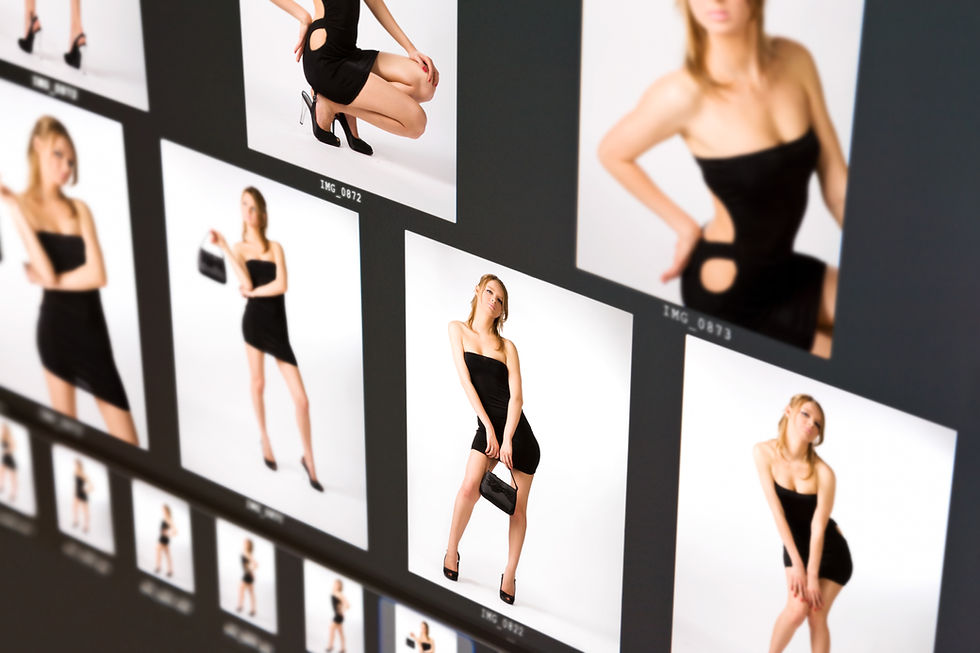How to Build a Compelling Portfolio for Aspiring Models
- David Arnold

- May 6
- 4 min read
Updated: May 13
Creating a successful modeling career starts with having a standout portfolio. This is your visual resume, showcasing your unique style and ability to potential clients and agencies. In this blog post, we will delve into the essentials of portfolio building, including its contents, types of photographs, and tips to present yourself professionally.
Portfolio Building: Understanding Its Importance
A modeling portfolio is essential for every aspiring model. It serves as the first impression for agencies and clients, showcasing your versatility, style, and what makes you unique. The right portfolio can open doors, lead to auditions, and ultimately land jobs. It's important that your portfolio captures not just your physical appearance but also your personality and modeling ability.
Models who invest time and resources into creating a professional portfolio often see increased opportunities. For instance, research shows that well-presented portfolios can lead to a 60% higher chance of being noticed by casting directors and agents.

What Should a Modeling Portfolio Consist Of?
A comprehensive modeling portfolio usually contains a variety of images that highlight your range and capabilities. Here’s what to include:
Headshots: These are essential for modeling. Include one or two close-up images that showcase your face without heavy makeup or filters. Make sure the lighting is flattering and natural.
Full-Body Shots: Potential clients often want to see your body type and how you carry yourself. Include images that portray your silhouette and the way you pose in various outfits.
Fashion Editorials: High fashion images or styled shoots can show your versatility. These shots can be more creatively styled and should reflect current trends.
Commercial Shots: Include images that convey a more relatable or approachable vibe. These can be lifestyle photos or advertisements showcasing brands you have worked with.
Editorial Layouts: If you have participated in fashion magazines or other print media, include these images in your portfolio.
Variety: Showcase different expressions, poses, and styles. This will help demonstrate that you can cater to a wide range of modeling opportunities.

Choosing the Right Photographers
The quality of your photographs is paramount. Selecting the right photographer can make a significant difference. Consider the following when choosing a photographer:
Experience: Look for photographers who specialize in modeling portfolios. This can ensure they have the specific skills to capture your best angles and expressions.
Portfolio: Review their past work to see if their style resonates with what you want to achieve.
Collaboration: The photographer should be someone you can communicate well with. It’s essential to feel comfortable to produce authentic images.
When collaborating, provide your photographer with mood boards or examples of images that inspire you. This can help both of you align on the desired direction of the shoot.
Presenting Your Portfolio Professionally
Once you have gathered your best images, the next step is to present them professionally. Here are a few tips:
Quality Over Quantity: Aim for a selection of about 15-20 high-quality images. It’s better to showcase fewer stunning images than to overwhelm potential clients with mediocre ones.
Format: Choose a clean and modern layout for your portfolio. Whether you go for physical prints or a digital website, make sure it is easy to navigate.
Contact Information: Always include your contact details or link to your modeling agency. This ensures clients can easily reach you for job inquiries.
Keep Updating: Your portfolio should evolve as your career progresses. Regularly update it with new images, reflecting your current look and style.

Building Your Brand
As an aspiring model, it's crucial to build a personal brand that reflects who you are. This involves creating a recognizable image and style that sets you apart from others. Consider the following aspects when developing your brand:
Social Media Presence: Utilize platforms like Instagram to share your journey. Post about your modeling experiences, and behind-the-scenes content, and engage with your audience.
Networking: Attend modeling events, workshops, and auditions to meet industry professionals. Building relationships can lead to opportunities and collaborations that enhance your portfolio.
Diverse Looks: Experiment with different styles, from casual to high fashion, to attract a wider range of clients. This versatility can broaden your appeal in the industry.
Final Thoughts on Portfolio Building
Building a compelling portfolio is a critical step for aspiring models. Focus on quality images, professional presentation, and nurturing your personal brand. Remember that your portfolio is an evolving project; as you gain experience and develop your style, don’t hesitate to update it.
By following the guidelines shared in this post, you can create a modeling portfolio that captures the attention of agencies and clients alike. Strive to showcase the best version of yourself, and keep pushing the boundaries of your creative expressions.
For more detailed assistance in building an outstanding modeling portfolio, check out this essential guide. Happy modeling!



Comments